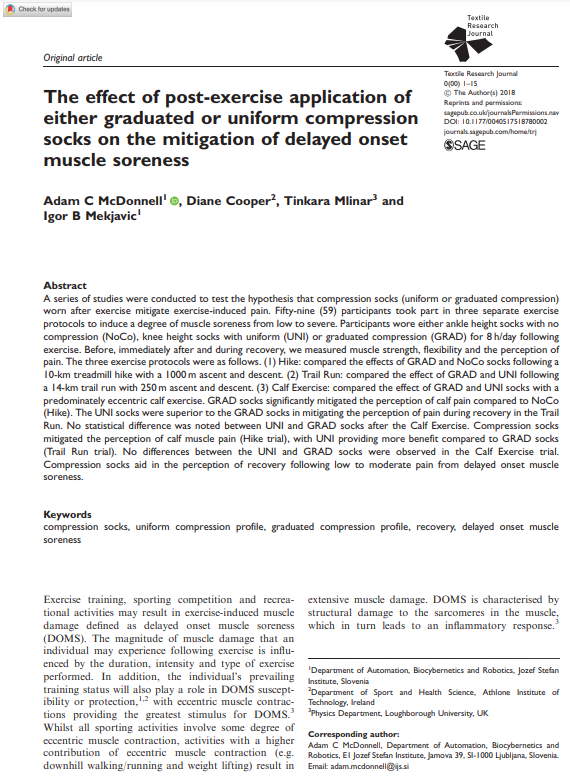
With St Jozef Stefan Institute, Ljubljana, Slovenia
With St Jozef Stefan Institute, Ljubljana, Slovenia
Dr Diane was invited and funded to travel to St Jozef Stefan Institute, Ljubljana, Slovenia, for four weeks to collaborate with Dr Adam McDonnell and Professor Igor Mekjavic. The research team investigated the ability of different types of compression socks to mitigate exercise-induced pain, particularly following a heavy eccentric training load.
Study details: A series of studies were conducted to test the hypothesis that compression socks (uniform or graduated compression) worn after exercise mitigate exercise-induced pain. Fifty-nine (59) participants took part in three separate exercise protocols to induce a degree of muscle soreness from low to severe. Participants wore either ankle height socks with no compression (NoCo), knee height socks with uniform (UNI) or graduated compression (GRAD) for 8 h/day following exercise. Before, immediately after and during recovery, we measured muscle strength, flexibility and the perception of pain. The three exercise protocols were as follows. (1) Hike: compared the effects of GRAD and NoCo socks following a 10-km treadmill hike with a 1000 m ascent and descent. (2) Trail Run: compared the effect of GRAD and UNI following a 14-km trail run with 250 m ascent and descent. (3) Calf Exercise: compared the effect of GRAD and UNI socks with a predominately eccentric calf exercise. GRAD socks significantly mitigated the perception of calf pain compared to NoCo (Hike). The UNI socks were superior to the GRAD socks in mitigating the perception of pain during recovery in the Trail Run. No statistical difference was noted between UNI and GRAD socks after the Calf Exercise. Compression socks mitigated the perception of calf muscle pain (Hike trial), with UNI providing more benefit compared to GRAD socks (Trail Run trial). No differences between the UNI and GRAD socks were observed in the Calf Exercise trial. Compression socks aid in the perception of recovery following low to moderate pain from delayed onset muscle soreness.
Research paper: The published paper can be accessed HERE
Research partners: Athlone Institute of Technology (Ireland), Loughborough Univeristy (UK), St Jozef Stefan Institute (Ljubljana).
